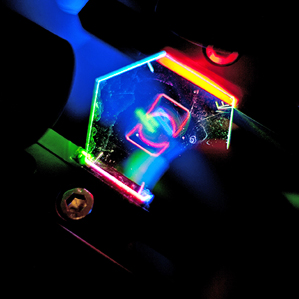New 3-D Display Could Let Phones and Tablets Produce Holograms
 Conventional 3-D—the type found in movie theaters—provides the viewer with only one perspective. The key to making a multiview 3-D display is reproducing all the light rays reflecting off an object from every angle and to get a different image to the left and right eye of the viewer. Some systems for producing multiview 3-D images require rapidly spinning mirrors; others use systems of lasers and multiple graphics processors.
Conventional 3-D—the type found in movie theaters—provides the viewer with only one perspective. The key to making a multiview 3-D display is reproducing all the light rays reflecting off an object from every angle and to get a different image to the left and right eye of the viewer. Some systems for producing multiview 3-D images require rapidly spinning mirrors; others use systems of lasers and multiple graphics processors.
The HP display uses nanopatterned grooves, which HP researcher David Fattal, who led the work, calls “directional pixels,” to send light off in different directions. This requires no new moving parts, and the patterns are built into an existing display component, the backlight.
The HP display replaces the randomly scattering bumps in a normal LCD with deliberately patterned grooves. Each “directional pixel” has three sets of grooves that direct red, green, and blue light in one particular direction. The number of directional pixels determines the number of viewpoints the display can produce. Light from the pixels then passes through a conventional array of liquid crystal shutters that pass or block the light to make a moving image—just like in a conventional LCD.
The HP researchers showed that they could make static images with 200 viewpoints, or videos with 64 viewpoints and 30 frames per second—so far.